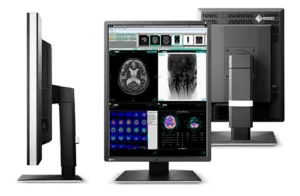Eizo’s newest medical monitor, the 3MP (2048 x 1536) 21.3″ Radiforce RX350, is designed to display chest X-rays, CR and DR images in greyscale, and colour images such as 3D renderings and image fusion.
The successor to the RX340, the RX350 features Eizo’s Sharpness Recovery technology. The firm explains that this is a way to restore lost sharpness information from ageing LCD panels (due to the pixels’ aperture ratio becoming larger, according to Eizo) in contours. A research study is being conducted on the RX350 by Emory University in the USA, to evaluate the user benefits of the new Sharpness Recovery technology.
A modulation transfer function (MTF) numerically measures how faithfully the display transfers detail from the original image data for viewing. With Sharpness Recovery – in the case of a two pixel line pair, MTF is said to increase by approximately 52%.
As a diagnostic unit, the RX350 is DICOM-compliant for its greyscale images. An integrated front sensor measures brightness and greyscale tones, with adjustments to re-calibrate being made automatically. Other correction methods are found in the Digital Uniformity Equaliser (ensuring brightness and colour uniformity) and drift correction (stabilising brightness when turned on or waking from sleep mode) features. A sensor is also installed that measures backlight brightness and compensates for ageing.
An anti-reflective layer is fitted to the display. Eizo has also shrunk the monitor’s chassis and stand, bringing screen position back 59.5mm and stand position back 45.5mm, to provide users with more desk space.
Brightness can reach 1,000 cd/m², although 500 cd/m² is recommended for calibration. An IPS panel provides a 1,500:1 contrast ratio, 178° viewing angles and 25ms response time. DisplayPort, DVI-D (x2), USB-A (x2) and USB-B ports are featured; the DisplayPort interface can be used to daisy-chain the monitor.
Analyst Comment
We clarified that the Sharpness Recovery system modifies the input signal to maintain contrast at high resolution, but we were unclear about the idea that LCDs have a changing aperture ratio over their lifetime. We’re following up on this with Eizo. (BR) See Eizo Sharpness Recovery Becomes Clearer for more information that arrived later.

